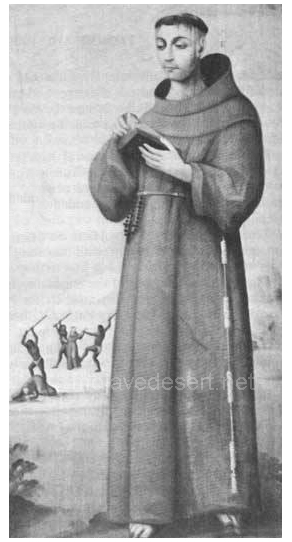The Good Padre's First Encounter

Even before reaching the
Needles
area,
Garces
recorded the
Mohave Indians
practice of obtaining captive slaves. (4) In fact, the good padre's first encounter with the Mohave resulted in the purchase of two captive
women slaves which he later released and sent back to their own villages. This purchase occurred while Garces was traveling up the Colorado
River from the Yuma villages toward the Mohave villages.
In another instance the Mohave received word of the Spanish visitors among the Yuma, and being an inquisitive people, they were approaching
the country of their southern friends to satisfy their innate curiosity. Garces shared his provisions with the Mohave party and discovered
they had with them two captive Jalchedun (Halchidhoma) (5) women. It took some insistent bargaining before Garces succeeded in purchasing
the two captive Indian women slaves with what he termed "a poor horse and some other small presents". After five more days of travel up
the river toward the Mohave villages, Garces sent the two women slaves home with an old interpreter who had been instructed to assure
the Halchidhoma of the missionary's friendship. Father Garces had principles of humanity not frequently encountered among mankind
throughout the world during the eighteenth century.
The origin of slavery among the Mohave Indians was undoubtedly connected with their warlike operations. The practice evolved from simply
killing their enemies to that of using
those captured for work and/or trade. During a long prehistoric period, they had captured or traded for women and children whom they
took back to their villages along the
Colorado River. There
the captured slaves were used to assist with the cultivation of crops planted in the rich soils of the overflow of the river. Sometimes
the captured children were permitted to grow up and live with the Mohave. Slave women were sometimes adopted, tattooed {a pic of a
tattooed woman, we have one or could get one} at puberty, and even married. In some instances the slaves were traded to other tribes,
killed, or even tortured until death resulted.
Olive Oatman,
whom the Mohave purchased from the Apache, was a white slave of the Mohave for approximately five years during the mid nineteenth century. She
related not only her own experiences, including being tattooed, but also the tribe's custom of killing a slave as a sacrifice should any
member of the tribe be killed in battle. (6) Slaves were often tortured and killed if they attempted to escape and were
recaptured. Lieutenant A. W. Whipple
noted when he was traveling through the Mohave villages in 1854 that "several sad looking fellows in the crowd were slaves." An Indian
war captive was considered a disgrace. Even if he were to be returned to his tribe, his family would discard him as unworthy.
< PREVIOUS - Indian Slave Trade - NEXT >